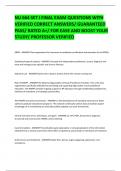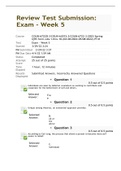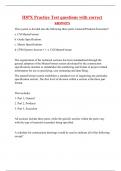NU 664 SET I FINAL EXAM QUESTIONS WITH
VERIFIED CORRECT ANSWERS/ GUARANTEED
PASS/ RATED A+/ FOR EASE AND BOOST YOUR
STUDY/ PROFESSOR VERIFIED
ARRN - ANSWER Clear expectations for licensures accreditation certification and education for all APRNs
Standards/scope of practice - ANSWER Licensed and independent practitioners, assess, diagnosis and
treat and manage acute episodic and chronic illnesses.
Statutory Law - ANSWER States have a duty to protect those who receive nursing care
Role of NONPF - ANSWER the National Organization of Nurse Practitioner Faculties. This is the only
organization specifically dedicated to promoting and supporting high quality nurse practitioner
education. The NONPF provides ongoing support to NP educators through establishing competencies,
methods of evaluation, and strategic partnerships.
The NONPF primarily concentrates - ANSWER on the development of standards necessary to foster
optimum graduate educational programs. This network continually collects data and utilizes expert
knowledge of its membership to seminally publish updated curricular frameworks
Clinical interview terms, techniques, and goals - ANSWER CC, HPI, PMH, Assessment, diagnosis,
structured and unstructured. MMSE, active listening.
Case formulation - ANSWER Theoretically based explanation or conceptualization of the information
obtained from a clinical assessment which offers a hypothesis and provides a framework of treatment.
Grief process and treatment - ANSWER Kubler Ross: denial, anger, bargaining, depression, and
acceptance.
,Instrumental: problem solving
Intuitive emotional
Risk assessment (suicide, self-harm, homicide, etc.) - protective and risks factors - ANSWER Highest risk
group- white, middle-aged males
Next highest- aged 85 and older
Screening tool- Ask Suicide-Screening Questions (ASQ) - ANSWER made of 4 questions to ask youth in
medical settings
Common screening tools - ANSWER PHQ-9 for depression
Columbia-Suicide Severity Rating Scale (C-SSRS)
SAFE-T (Suicide Assessment Five-Step Evaluation and Triage)
Highest risk for self-injury - ANSWER socioeconomic disadvantage, depression, substance abuse, and
anxiety
Self-injury increases - ANSWER risk of later suicide
Primary prevention - ANSWER concerned with the prevention of the onset of disease; goal is to reduce
the incidence of disease; e.g. vaccinations
Secondary prevention - ANSWER concerned with trying to detect a disease early and prevent it from
getting worse; e.g. regular exams and screening tests
Tertiary prevention - ANSWER concerned with reducing the impact of an ongoing illness or injury that
has lasting effects; e.g. cardiac or stroke rehab programs, support groups
Levels of prevention - ANSWER primary, secondary, tertiary - this is important for public patient
education/screening/epidemiological measures, and promoting health.
, Neuroanatomy - ANSWER neurotransmitters, brain plasticity, epigenetics, major areas of the brain such
as the amygdala, prefrontal cortex, hypothalamus
Dopamine - ANSWER responsible for drive, motivation, and reward, inhibition of prolactin, controls
motor (imbalance causes Parkinson's, extapyramidal symptoms)
Serotonin - ANSWER satisfaction, sociality, lowers anxiety and impulsivity, decreases sex drive, 90%
serotonin in GI tract
-Too much- bleeding, GI motility, nausea
- Zofran blocks serotonin
Norepinephrine - ANSWER concentration, attention, vigilance, energy, tachycardia, HTN, glucose to
essential organs
-Fear increases NE to brain, epinephrine to blood
-Fight or flight
Glutamate - ANSWER being "on", excitatory (think gluta-MATE mating)
GABA - ANSWER being "off", inhibitory, relaxation, euphoria, decreases muscle activity, slows breathing,
decreases anxiety and seizures (think gabapentin)
Acetylcholine - ANSWER bradycardia, GI motility, salivation, lacrimation, urination, sexual arousal,
muscle contraction
- In the hippocampus- learning, memory, awakeness, attention
Histamine - ANSWER Hayfever
Itching
Sleeping
Think Benedryl helps with theses (ANTIhistamine)
Limbic System - ANSWER · emotion






